
|
Astronomy Picture Of the Day (APOD)
 COBE Hotspots: The Oldest Structures Known
COBE Hotspots: The Oldest Structures Known
5.02.1996
Above are two microwave images of the sky, looking north and south of our galaxy's equator, based on data from NASA's COBE satellite. After computer processing to remove contributions from nearby objects and the effects of the earth's motion, they show "spots".
 COBE Dipole: Speeding Through the Universe
COBE Dipole: Speeding Through the Universe
4.02.1996
Our Earth is not at rest. The Earth moves around the Sun. The Sun orbits the center of the Milky Way Galaxy. The Milky Way Galaxy orbits in the Local Group. The Local Group falls toward the Virgo Cluster of Galaxies.
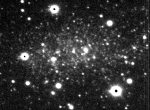 The Closest Galaxy: The Sagittarius Dwarf
The Closest Galaxy: The Sagittarius Dwarf
3.02.1996
What's the closest galaxy to our Milky Way? For many years astronomers thought it was the Large Magellanic Cloud (LMC). But the seemingly insignificant fuzzy patch shown above turned out to be part of a galaxy that is even closer.
 A Huge Impact Crater on Mars
A Huge Impact Crater on Mars
2.02.1996
What hit Mars? The impact crater Schiparelli near the center of the above image was likely caused by a collision with an object the size of an asteroid. Also evident in this full face mosaic of Mars are numerous craters from many other impacts with smaller objects over billions of years.
 A MACHO View of Galactic Dark Matter
A MACHO View of Galactic Dark Matter
1.02.1996
What is our Galaxy made of? Stellar motions indicate there is much more mass than just stars and gas. Photographs like the two shown above may be yielding a clue about the dark matter, however.
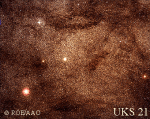 Lensing through Baade's Window
Lensing through Baade's Window
31.01.1996
What is the shape and composition of our Milky Way Galaxy? This question would be easier to answer if there wasn't so much obscuring dust! In the 1940s, however, astronomer Walter Baade identified a "window" near the center of our Galaxy where there is comparatively little opaque dust.
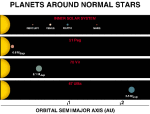 Planets Around Sun-Like Stars
Planets Around Sun-Like Stars
30.01.1996
Do many Sun-like stars have planets? Speculation on this point has been ongoing since humanity's realization that other stars existed. Only in the past year, however, have answers and discoveries been realized. The above plot summarizes the four known cases of normal stars having planets.
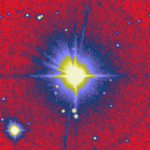 70 Virginis b: A New Water Planet?
70 Virginis b: A New Water Planet?
29.01.1996
The star 70 Virginis has a planet. This recent discovery is the second known case of a planet orbiting a normal star other than our Sun itself. The first case involved 51 Pegasi and was announced last year.
 Searchlight Beams from the Egg Nebula
Searchlight Beams from the Egg Nebula
28.01.1996
The dramatic and mysterious looking object revealed in this Hubble Space Telescope image is known as the Egg Nebula. It is an aging star about 3,000 lightyears distant, entering its Planetary Nebula phase of evolution.
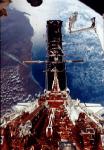 Orbiting Repairmen
Orbiting Repairmen
27.01.1996
In December of 1993 astronauts Story Musgrave and Jeffrey Hoffman performed the orbiting repairmans' ballet 400 miles above the Earth. They are seen in this photo perched at the end of the Space Shuttle Endeavour's robotic arm making final repairs to the four story tall Hubble Space Telescope.
|
January February March April May June July August September October November December |
||||||||||||||||||||||||||||||||||||||||||||||||||||||||